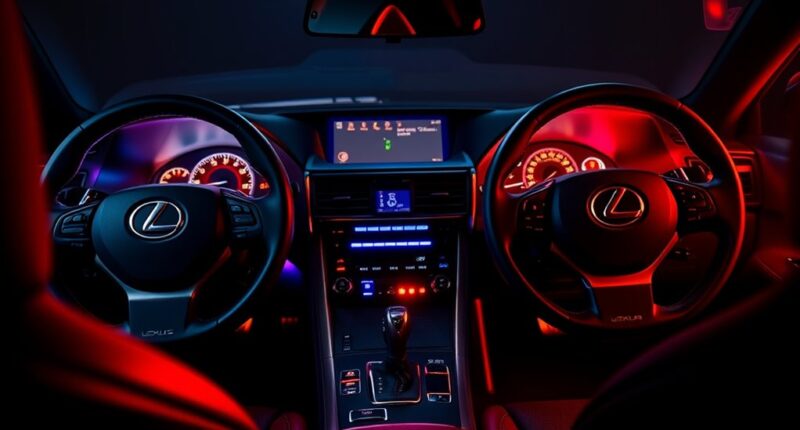If you’re looking for shift lights for your Lexus IS F or RC F, you’ll find OEM systems that display RPM indicators to help optimize your gear changes. These are integrated into the instrument cluster and mainly work in Sport modes, offering visual cues for peak performance. For more personalized options, aftermarket solutions are available that can be installed to match your driving style. Keep exploring to learn how to customize and maintain these systems for the best experience.
Key Takeaways
- OEM shift lights are integrated into the tachometer for Lexus IS F and RC F, indicating optimal shift points during aggressive driving.
- Aftermarket shift light systems can be customized and installed to enhance visibility and performance for these models.
- Proper wiring to the RPM signal and secure mounting are essential for reliable OEM or aftermarket shift light operation.
- Compatibility with vehicle electronics and safety features should be verified before installing aftermarket shift light systems.
- Regular maintenance and professional installation help ensure system reliability and preserve vehicle warranty.
Understanding the Shift Light System in Lexus F Models
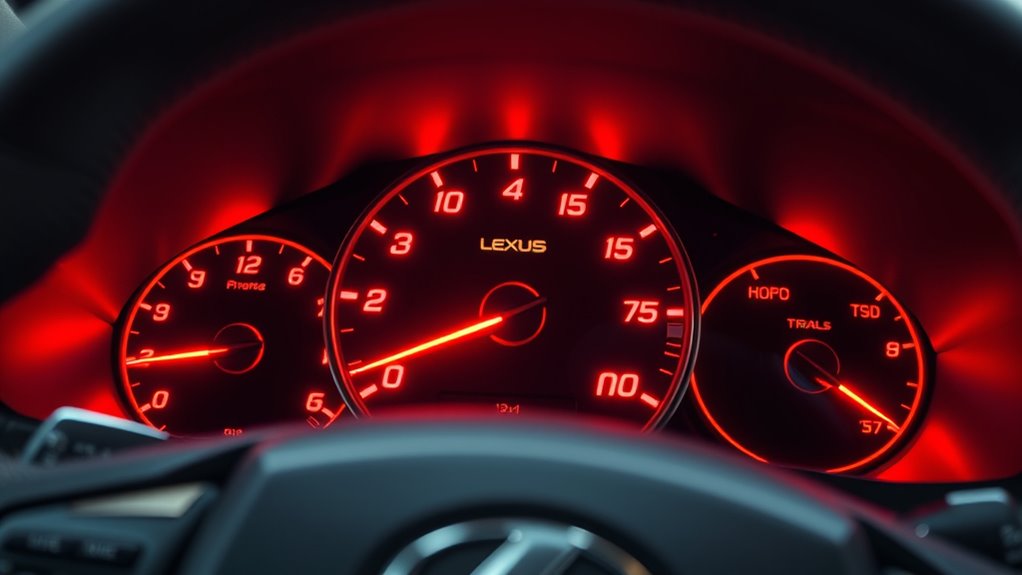
The shift light system in Lexus F models helps you optimize performance by signaling the ideal points to shift gears. This system is integrated into the vehicle’s performance instrumentation, usually embedded in the tachometer or center cluster, making it easy to monitor during spirited driving. When the engine approaches the peak power zone, the shift light activates, prompting you to shift at the optimal RPM for maximum acceleration and efficiency. It’s especially useful in Sport S/S+ modes, where shift points are adjusted for aggressive driving. Customization options may exist depending on your model and year, allowing you to tailor the alert to your preferences. Overall, this system enhances driver engagement and helps you extract the best performance from your Lexus F.
OEM Shift Light Features and Limitations
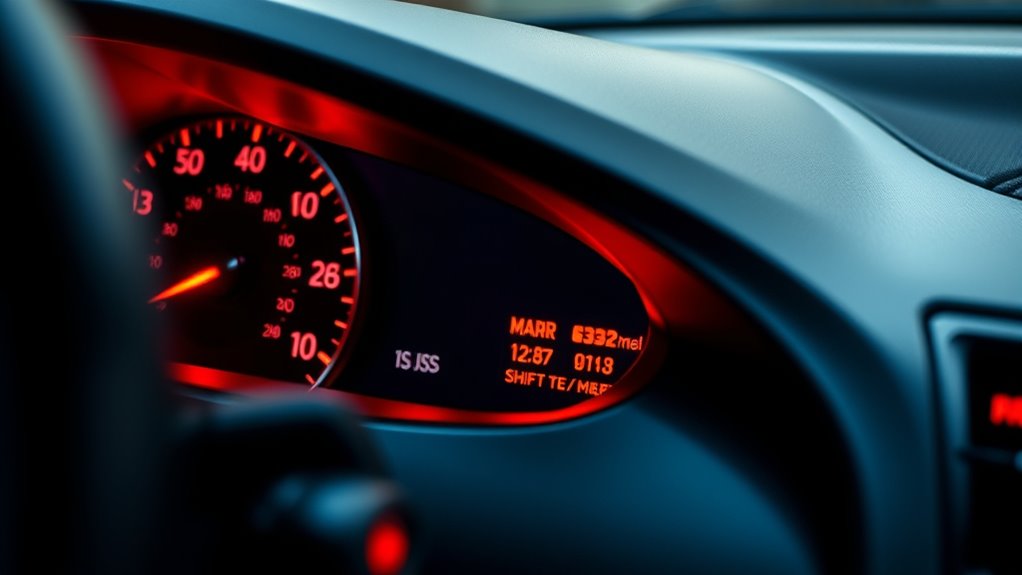
Lexus’s OEM shift light system offers a straightforward visual cue to help you optimize gear changes, especially during spirited driving sessions. In Sport S Mode, it features a three-stage rev indicator that *progresses* from yellow to orange to red, signaling ideal shift points. However, in Normal Mode, the system relies on a 270-degree tachometer without *gradual* color alerts, limiting visual guidance. Eco Mode uses blue indicators to reflect driving efficiency, but aggressive acceleration causes the display to deplete. The system lacks audio or visual warnings for missed shifts or overrevving in any mode, reducing proactive feedback. Drive mode-specific displays prioritize speed, shift, or efficiency metrics, but there’s no user customization or adjustable brightness. Overall, while effective, the OEM shift light system has notable limitations in flexibility and advanced warning features.
Compatibility of Aftermarket Shift Light Accessories

Aftermarket shift light accessories are generally compatible with models like Lexus IS-F and RC F, offering a versatile upgrade to factory systems. You’ll find options like LED strip lights and gear shift knob lights designed to fit these vehicles. Compatibility is often guaranteed through detailed lists from manufacturers, covering models such as NX200, 300, and RX500. Here are some key points to consider: 1. Most products use high-quality materials like ABS plastic and durable LEDs for long-lasting performance. 2. Many shift lights are designed to mimic OEM features for seamless integration. 3. You might need additional wiring or connectors for proper installation, especially for sensors and power sources. 4. Incorporating AI-powered customization can help tailor the shift light settings to your driving style and preferences. Additionally, ensuring proper installation and understanding the compatibility guidelines can prevent potential issues and improve overall functionality. Being aware of local regulations regarding vehicle modifications can also ensure your upgrades remain compliant and safe. Moreover, selecting accessories with robust build quality can enhance durability and performance over time.
Installing Aftermarket Shift Light Solutions
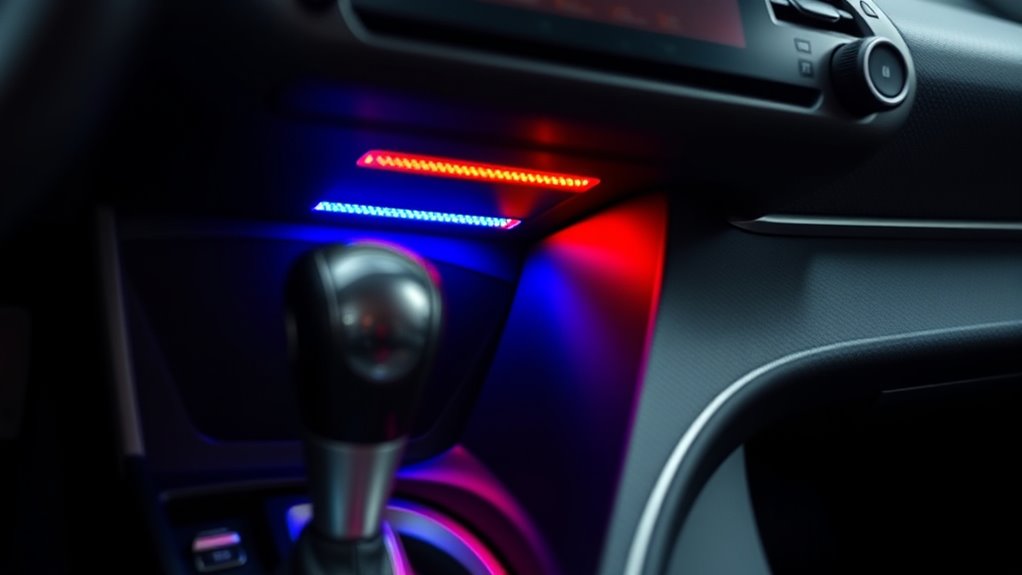
Installing aftermarket shift light solutions involves a straightforward process, but it requires careful planning and attention to detail. First, gather the necessary hardware like LED lights or digital displays, and ensure you have the right tools such as a Dremel or drill, wiring, connectors, and mounting hardware. Connect the shift light to the vehicle’s RPM signal source, typically the tachometer or OBD-II port, making sure to match the voltage at 12V and properly ground the system. Manage the wires neatly, securing them to prevent damage or electrical issues. Mount the shift light in your line of sight, often on the dashboard or steering column. Before completing the installation, test the setup to verify proper operation and adjust positioning as needed for ideal visibility. Additionally, understanding how to shift gears smoothly can enhance your driving experience and prevent unnecessary wear on your vehicle’s drivetrain. Incorporating Volkswagen Tuning principles, such as optimizing engine performance, can further improve your vehicle’s responsiveness during shifts. Being aware of proper wiring techniques and electrical safety helps ensure a reliable installation and long-term functionality. Moreover, researching local regulations can prevent potential issues related to aftermarket modifications.
Customizing Shift Light Settings and Alerts
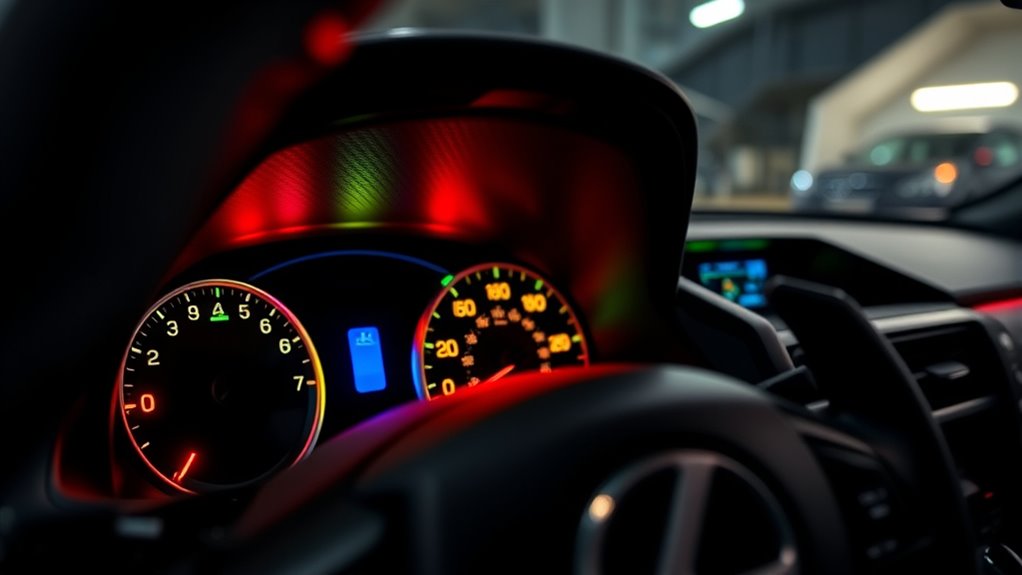
Customizing shift light settings and alerts on your Lexus IS F or RC F is limited by the factory’s built-in options, which primarily focus on comfort and convenience rather than performance notifications. You won’t find OEM shift light adjustment options in the system menus, and dealer intervention is needed for deeper ECU tweaks. If you want more control, consider third-party solutions. Here are some ways to customize:
- Use aftermarket OBD-II devices with apps like OBD Fusion to visualize shift timing indirectly.
- Install external alert systems via CAN bus connections, often requiring professional wiring.
- Explore community workarounds, such as DIY LED overlays or Arduino-based RPM triggers, for personalized alerts.
- Be aware that security vulnerabilities in new technologies can pose risks if not properly managed, especially when integrating third-party devices.
- Understanding financial management principles, like budgeting for modifications, can help you plan and afford these upgrades responsibly.
These options help you personalize shift notifications beyond factory limits.
Enhancing the Driving Experience With Visual Cues
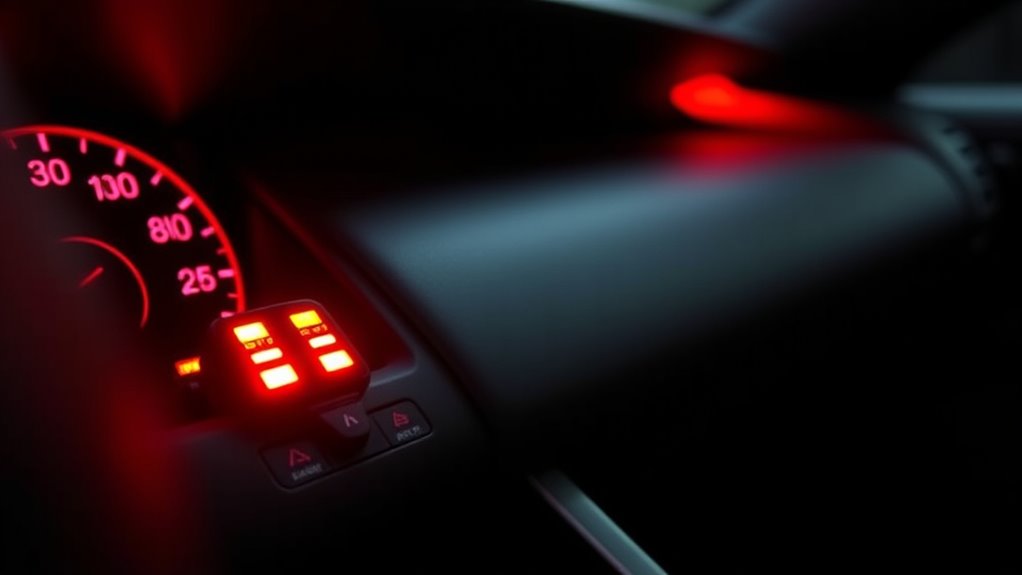
Enhancing your driving experience with visual cues allows you to stay engaged and maximize performance, especially during spirited driving or track sessions. The RC F’s paddle shifters and SPDS display give real-time feedback on gear position and shift logic, helping you time shifts precisely. Curve detection automatically holds lower gears during cornering, ensuring the engine stays in its optimal RPM range. The Takumi-tuned 5.0L V8 produces peak torque between 4,800–5,600 RPM, so clear visual cues help you maximize power delivery. Ambient lighting that shifts with driving modes and carbon fiber accents create an immersive, performance-focused cockpit. Aftermarket options like RPM-based shift lights and HUD projections supplement factory cues, further sharpening your reaction times and maintaining focus during high-performance driving. Understanding driver assistance features can further enhance safety and control during dynamic driving conditions. Additionally, driver feedback systems can provide real-time alerts that enhance your ability to respond quickly to changing road conditions. Incorporating visual driving aids can also improve situational awareness and driving precision in demanding environments.
Considerations for Safety and Vehicle Warranty

When considering modifications like aftermarket shift lights, it’s important to understand how they may impact your vehicle’s safety features and warranty coverage. Installing these lights can enhance driver awareness but might also void parts of your warranty if not done properly. To protect yourself, keep these points in mind:
- Consult your dealership before making any modifications to ensure your warranty remains intact.
- Use manufacturer-approved parts or ensure proper documentation to avoid warranty exclusions.
- Verify that aftermarket components won’t interfere with safety systems like Pre-Collision or Lane Tracing Assist.
- Be aware that Best Airless Paint Sprayers can provide insights into proper installation and maintenance practices to prevent unintended system interference. Additionally, understanding vehicle wiring systems can help ensure that the installation does not disrupt existing electronic components. Familiarity with your vehicle’s electronic control modules can further assist in avoiding system malfunctions during upgrades. Moreover, a thorough understanding of electrical circuits can aid in preventing potential damage or malfunctions caused by improper modifications.
Proper integration is key to maintaining safety and performance. Remember, compatibility with existing systems ensures your vehicle’s safety features continue functioning as intended, even after upgrades.
Cost and Options for Upgrading Shift Light Functionality

Upgrading the shift light functionality on your Lexus IS F or RC F offers a range of options to suit different preferences and budgets. Basic LED downloads cost between $100 and $500, while advanced systems with extra features can reach $1,500. Customizable LED lights, allowing personalized settings, range from $1,000 to $3,000. Professional installation adds $200 to $500, and electronic integration kits cost $300 to $1,000. Considering compatibility with automotive scan tools can help ensure seamless integration with your vehicle’s existing systems. Additionally, understanding regulatory compliance is important when installing aftermarket modifications to avoid potential issues. Properly tuning your shift light system can also improve driver responsiveness and vehicle safety. Incorporating user preferences into the configuration can further enhance your driving experience. Engaging in self-awareness during customization can help you tailor the system to your specific driving style and needs.
Tips for Maintaining and Troubleshooting Your Shift Lights

Regular maintenance and prompt troubleshooting keep your shift lights functioning reliably on your Lexus IS F or RC F. To guarantee peak performance, start with these tips:
- Inspect components regularly — check LED lights and related parts for signs of wear or damage.
- Perform circuit checks — look for corrosion or damage in electrical circuits connected to the shift lights.
- Update software — keep your vehicle’s electronic control unit firmware current for seamless shift light operation.
- Stay informed about automation advancements that could impact your vehicle’s electronic systems and overall performance.
- Understand electrical systems within your vehicle, as familiarity can help in diagnosing issues more effectively.
Additional tips include diagnosing error codes with diagnostic tools, using multimeters to detect electrical issues, and verifying physical damage. Adjust sensitivity settings and customize shift points to match your driving style. Regular maintenance, quick troubleshooting, and staying updated help keep your shift lights reliable and effective for a smooth driving experience.
Frequently Asked Questions
Can Shift Lights Alert for All Gear Shifts in Lexus RC F?
You’re wondering if shift lights can alert you for all gear shifts in your Lexus RC F. Usually, the shift indicator sounds are most noticeable in lower gears, like from 1st to 2nd, especially near the rev limiter. However, they don’t consistently alert for every gear change, particularly in higher gears. The system mainly provides visual cues, and customization for all shifts isn’t available. So, full gear shift alerts via lights aren’t standard.
Are There Wireless or Bluetooth Options for Aftermarket Shift Light Systems?
Did you know over 70% of drivers prefer wireless tech for easier upgrades? When it comes to aftermarket shift lights, wireless or Bluetooth options are rare but accessible. You can find some systems that allow app-based control, but they often need advanced setup and reliable connections. Keep in mind, though, wireless systems may have limitations in compatibility and stability, so choose carefully to ensure safe, seamless performance.
Do Aftermarket Shift Lights Affect the Vehicle’s Electrical System or Warranty?
You might wonder if aftermarket shift lights impact your car’s electrical system or warranty. Generally, if you install a quality kit correctly, it adds minimal electrical load and usually won’t cause issues. However, improper installation or low-quality components could cause electrical problems or interference. Plus, some manufacturers might void your warranty if modifications aren’t approved, so it’s wise to check your vehicle’s warranty policy and follow installation guidelines carefully.
How Can I Sync Shift Lights With Engine Revs Accurately?
To sync shift lights with engine revs accurately, you should monitor your engine’s RPM closely using the vehicle’s built-in gauges or an aftermarket device. Adjust the shift light settings to activate at your preferred RPM threshold, typically around 6,000 to 7,000 rpm for high-performance driving. Test and fine-tune these settings during different driving modes, ensuring the lights signal at the right engine speed for ideal shifting.
Are There Legal Restrictions on Installing Custom Interior Lighting Like Shift Lights?
Like steering a maze of rules, installing custom interior lighting involves strict legal boundaries. You should check your state’s specific laws, as many prohibit visible blue or red lights, especially if they mimic emergency signals. Interior-only lights are usually permitted if they aren’t visible externally and don’t distract you while driving. Always guarantee your modifications meet DOT or SAE standards to avoid fines, voided insurance, or legal trouble.
Conclusion
Mastering your Lexus F’s shift lights is like tuning into a secret rhythm that makes every drive feel alive. By customizing and maintaining these visual cues, you’re not just shifting gears—you’re orchestrating a symphony of performance and safety. Think of it as your car’s heartbeat, guiding you smoothly through every twist and turn. Embrace these lights, and turn your driving experience into a seamless dance on the road.
